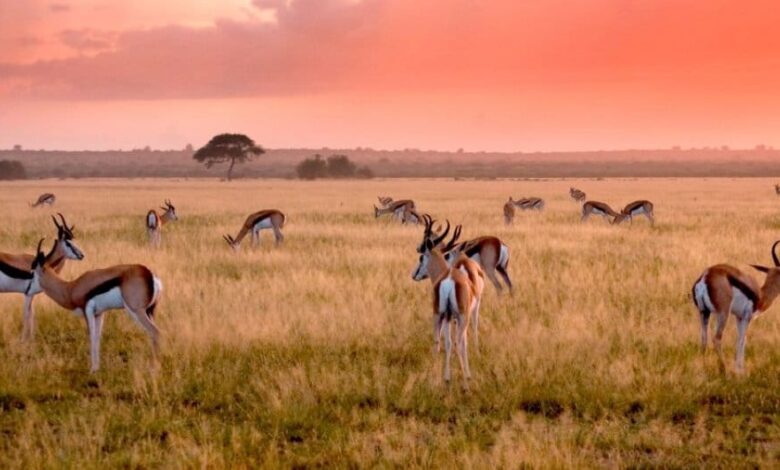MINING CADASTRE HYDROCARBON SCRAMBLE IN ICONIC KALAHARI GAME RESERVE

The world’s second-largest reserve, the remote CKGR is home to a plethora of African flora and fauna including the Big 5, and is a sacred ancestral homeland of the San Bushmen whose forced removal from the park, ostensibly for conservation purposes, has been widely documented.
DM168 can reveal that about half the surface area of the 52,800 square- kilometers park — about two and a half times the size of the Kruger National Park has been allotted into blocks for exploration for oil, gas, coal, coalbed methane, and other minerals and metals. This raises obvious environmental concerns as well as questions about funding sources for such projects in an age when the green energy transition is in full swing and bankers are increasingly reluctant to fund fossil fuel initiatives, notably for coal.
But the Botswana government cannot be accused of granting such licenses on the sly. It’s all there, plain as day, on the country’s mining cadastre, which recently went live. A mining cadastre is an online portal that allows the public access to view existing mining rights, exploration permits, and related things.
For starters, a little-known company called Pelkbuck was awarded an exploration license for natural gas and petroleum on 1 October 2021 over a series of blocks amounting to almost 45,000 square kilometers, most of them in the CKGR. DM168 could not find a website for Pelkbuck, and the scant references to oil and gas exploration services by that name show a privately-held entity based in the British Virgin Islands, a tax haven. This does not mean the company is dubious; it just raises red flags around transparency.
A company called Equitorial Oil and Gas — the curious spelling is what the cadastre shows — has a prospecting license for coal and coalbed methane in the park, and another one that has been suspended. The Botswana government’s official Daily News did announce in August 2020 that Equitorial Oil and Gas had been issued with a petroleum exploration license, without specifying where at the time.
Alloys and Minerals Botswana has one for coal and coalbed methane in the park covering 954 square kilometers. Coalbed methane is a natural gas extracted from coal beds and is a source of greenhouse gas emissions (CGE). There is an abundance of it under the sands of the Kalahari.
Various other small companies also have prospecting or exploration permits in the park — the total is over two dozen. Not all are for hydrocarbons. Some are for other valuable commodities including diamonds and it is widely known that Gem Diamonds is currently operating the Ghaghoo diamond mine in the park. But the precise nature and scale of hydrocarbon exploration in the park were poorly known until the government’s cadastre went live, bringing instant transparency.
There is a prospecting license for diamonds in a slither of the southwest corner issued to Diamexstrat Botswana, a subsidiary of Diamond Exploration Strategies, a private UK-registered company. Another difference with the leaked map from a decade ago is the park’s northwest corner. Australia and AIM-listed Tlou Energy Resources have prospecting licenses for coal and coalbed methane near the park’s southeast boundary, but not inside the conservation area, the cadastre shows.
De Beers operates in the country through a joint venture with the Botswana government called Debswana. It is also a unit of Anglo American, which is at pains to burnish its ESG — environmental, social, and governance — credentials, and would likely face shareholder and public blowback to any intrusion into an African game reserve of such significance.
However, Kavango Minerals — a unit of LSE-listed Kavango resources — has a prospecting license on a tiny block of 390 square kilometers inside the park’s eastern rim for a range of metals and minerals including copper, gold, cobalt, manganese, and platinum group metals.
The cadastre also shows that the main body of the Okavango Delta has no activity linked to extractive industries, nor the Chobe National Park in northern Botswana which boasts the world’s largest concentration of elephants, with numbers estimated at around 120,000.
Its exploration license is denoted on the cadastre, and alarm bells have been ringing as its permits straddling the border overlap the ecologically sensitive Kavango-Zambezi Transfrontier Conservation Area upstream from the Okavango Delta. The cadastre also demonstrates that the area is a hive of activity for prospecting for uranium and other valuable metals and minerals including PGMs, nickel, copper, cobalt, and others.
On a global scale, many of these metals are found in, and are sure to be uncovered, in areas of ecological importance and fragility, taking some of the “green” sheens off the transition.
Source: Daily Maverick



